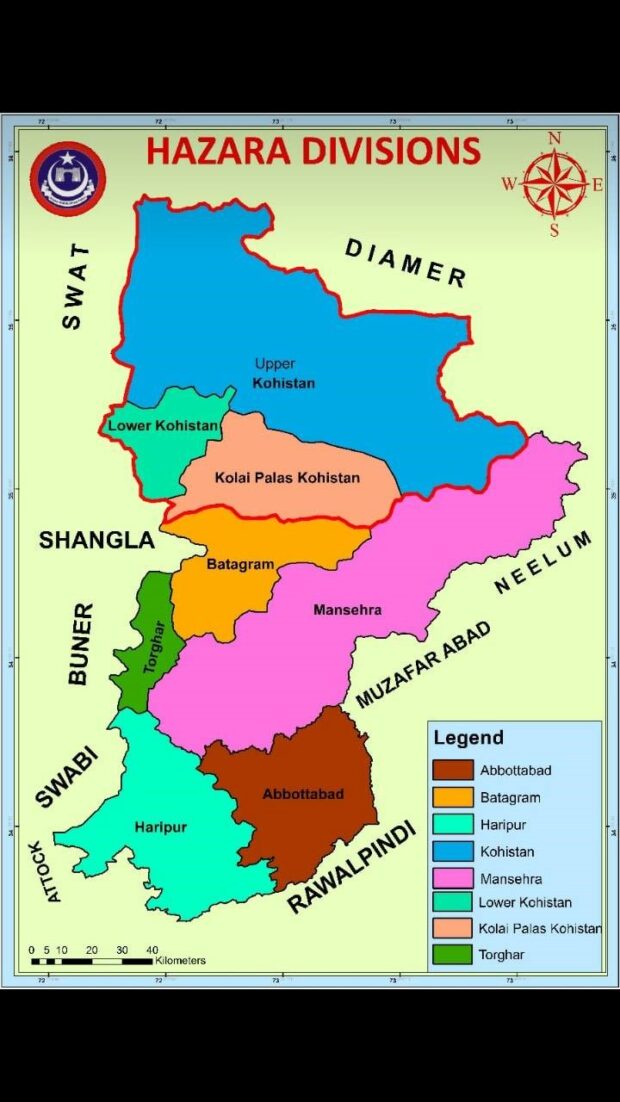By Dr Hassan Farooq Mashwani
All over the world there are certain regions and states that are particularly famous for various natural, industrial, technological and educational peculiarities. These attributes render superior position against others for they earn greater fame, name, revenues, jobs and quality of life for a nation. Likewise, at the states levels there are certain localities that are specifically known for certain attributes like; natural resources and finished products, which are acknowledged and appreciated at the domestic as well as international levels. In Pakistan some of the regions are specifically famous for their natural resources, industrial goods, agricultural products, tourism and other yields.
There are very few places in the country, having greater economic and geo-strategic prominence and privileges in multiple areas; certainly Hazara Division could one among such zones. Hazara is enjoying a key position in Pakistan for its extraordinary contribution in diverse fields of national resources like; hydroelectric power generation capacity, industrial goods, water reservoirs, tourism, education facilities, jobs creation, revenue generation and range of strategic installations. Hence, Hazara Division can be attributed as one of the most significant geo-strategic regions in the country.
Brief Introduction of Hazara:
Hazara region, for its multifarious conventional and strategic features, is one of the most vital areas of Pakistan. Situated at the NorthEast part of the Khyber Pakhtunkhwa(KPK) Province as well as Pakistan, it occupies a highly significant geostrategic position not only in the KPK province but also in the entire country.Hazara region comprises of;Abbottabad (the capital), Haripur, Mansehra, Battagram,Torghar (Kala Dhaka),Upper Kohistan, KolaiPalas Kohistan and the Lower Kohistandistricts. It is surrounded by Diamer district of the Gilgit Baltistan (GB) at the North; Muzafar Abad and Neelum districts of Azad Kashmir at the East; Rawalpindi, Attock and Islamabad (the capital) at the South; Swabi, Buner, Shangla and Swat districts of Khyber Pakhtunkhwa lie at the West of Hazara region. The Indus, the most significant water and energy resource and the largest river of Pakistan, runs through Hazara from North to South. According to the census of 2017, the overall population of Hazara is more than 5.3 million (Province Wise Provisional Results of Census – 2017) and its area is 18,013 km2.
Geographically Hazara Division is an extremely vital locality not only in Pakistan but also in the entire region. It links Islamabad, the Punjab province, the rest of Khyber Pakhtunkhwa province and the Azad Jammu and Kashmir (AJK) with each other. The same link further extends to the Pakistan-China border through Gilgit Baltistan (GB) region. A huge portion of Karakorum Highway (KKH) between Pakistan and China runs through Hazara Division. The KKH has been the only road link between the two strategic neighbors, Pakistan and China, for the last four decades. The initiation of China Pakistan Economic Corridor (CPEC), the flag ship project of China as the rising great power, has further augmented the position of Hazara,as the Division accounts for numerous key projects of this game changing initiative.
A large number of geostrategic installations like dams, energy generation projects, industrial zones, education and training institutions, Sino-Pak future trade routes of the key nature are either situated or passing through Hazara region. Moreover, the area is also extremely rich in historical, cultural and tourist resorts that attract hundreds of thousands travelers, adventurers and vacationers every year from Pakistan and also from around the world. All these reputable attributes of the region certainly supplement towards the rehabilitation efforts of the dwindling economy of Pakistan.
Water and Power Projects/ Potentials in Hazara:
Generation of low-cost energy and storage of water is one of the most critical challenges for any state around the world. The ever growing modernization demand cheaper energy for the industrial and domestic usage. At the same time scarcity of irrigation and drinking water is also a great challenge for the developing and developed world and Pakistan is no exception. Right from the time of her independence,Pakistanhas been facing acute shortage of both these commodities. In 1947, the country had an overall installed power generating capacity of only around 60 Mega Watts.
By 1959, when the Water and Power Development Authority (WAPDA) was constituted,the total power generating capacity of Pakistan was increased up to mere 119MW. On the other hand, there were no substantial arrangements for water storage and floods regulatory mechanism in the country. Every year the country faced heavy floods in the monsoon seasons.
By virtue of Terbela Dam, Khanpur Dam and the barrage and water channel of Ghazzi Bhrotha power project, Hazara Division has been playing ahighly significant role in strengthening the water and power management system of Pakistan. In addition there are various other hydroelectric power generation initiatives in the region like Dasu Hydropower Project and Suki Kinari Hydro-Power Project that would help in addressing the energy shortfall of Pakistan along with water management in the country.-(To be continued)




